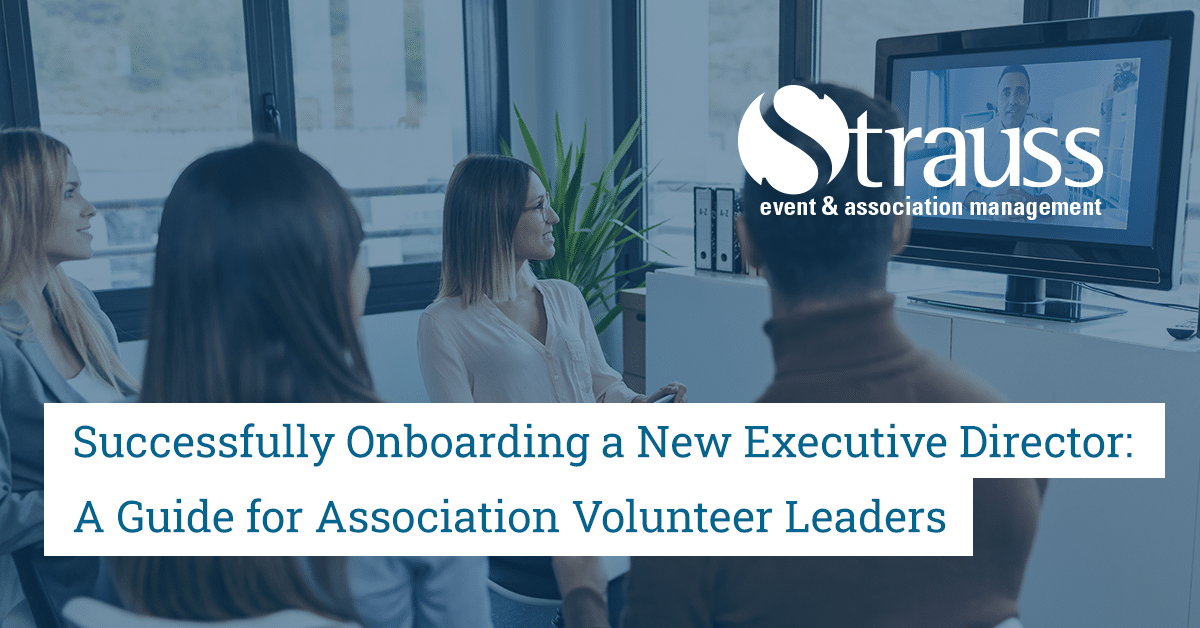The appointment of a new executive director marks a significant milestone for any association, symbolizing a time of transition, opportunity, and, above all, renewed leadership. It is essential for volunteer leaders on association boards to actively support the executive director in their new role, facilitating a smooth transition and ensuring they are equipped with the necessary tools needed for future success.
Association volunteer leaders must understand that the onboarding process is most important! Onboarding is more than just a series of introductions; it’s an opportunity to establish a strong foundation for future collaboration, communication, and collective cooperation amongst all parties. A well-structured onboarding process can significantly impact the executive director’s ability to lead the association effectively and successfully achieve the associations short-term and long-term strategic goals.
To ensure association volunteer leaders offer effective support during the onboarding process, refer to the comprehensive guide below:
Step 1: Pre-Arrival Preparations
Before the Executive Director’s first day, association volunteer leaders should:
- Develop a Clear Onboarding Plan: Outline key milestones, meetings, and training sessions taking place during the first few months. This plan should include introductions to key staff, board members, and active stakeholders.
- Assign a Mentor or Liaison: Select a tenured board member to act as a mentor or liaison to the executive director, providing guidance and support as they navigate through their new role.
- Prepare Essential Documents: Compile a comprehensive package of essential documents, including strategic plans, bylaws, recent board meeting minutes, financial reports, and an organizational chart.
Step 2: Formal Introduction to the Association
In the initial weeks, the emphasis should be on formal introductions and the gradual integration of the executive director into the association’s culture: This approach includes:
- Welcome Meetings: Organize meetings with board members and key staff to formally welcome the executive director. This is an opportunity for personal introductions and to express the board’s support and enthusiasm for the new leadership.
- Strategic Discussions: Arrange for the executive director to have one-on-one meetings with board members to discuss the association’s strategic goals, challenges, and opportunities from various perspectives.
- Deep Dives into Association: Ensure that the executive director has the chance to gain a comprehensive understanding of the association’s operations, programs, and services. This can be achieved through site visits, key program activities, and meetings with program leaders.
Step 3: Establishing Communication and Reporting Protocols
Clear communication channels between the executive director and the association’s volunteer leaders are crucial. To ensure effective communication, association volunteer leaders should:
- Define Communication Preferences: Discuss and agree on preferred methods and frequency of communication. Whether it’s through regular emails, weekly calls, or monthly reports, establishing these protocols early onwards ensures that all parties stay informed and engaged when necessary.
- Set Up Regular Check-Ins: Schedule regular check-in meetings between the executive director and the board chair or mentor to discuss progress, address challenges, and adjust the onboarding plan as needed.
Step 4: Aligning on Strategic Goals and Expectations
Alignment on strategic goals and expectations is critical for a successful partnership: To ensure alignment, association volunteers leaders should:
- Conduct a Strategy Workshop: Early in the executive director’s tenure, a workshop with the board and the executive director should be scheduled to ensure alignment on the association’s strategic direction and priorities. This approach ensures that everyone is on the same page and committed to the same outcomes.
- Clarify Roles and Responsibilities: Clearly define the executive director’s roles and responsibilities in relation to the board. This approach includes outlining decision-making powers, reporting structures, and evaluation practices.
Step 5: Supporting Professional Development and Network Building
Supporting the executive director’s professional development and integration into the industry benefits everyone involved. This approach includes:
- Encouraging Professional Development: Support the executive director in identifying and participating in professional development opportunities that align with the strategic needs of the association.
- Facilitating Network Building: Introduce the executive director to key industry leaders, partners, and other stakeholders. Encourage the executive director’s involvement in relevant industry groups and events to help build their network and raise the profile of the association.
Onboarding a new executive director is a crucial process that demands careful planning, open communication, and collaborative effort. By following the outlined steps, association volunteer leaders can ensure a smooth transition, build strong partnerships, and establish a foundation for achieving both short-term and long-term strategic goals. The success of the executive director is inherently tied to the success of the association, making their onboarding a top priority for the associations volunteer leaders.

